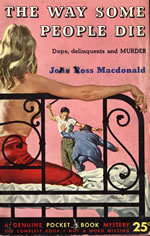The Way Some People Die
 Cover Artist: Clyde Ross
Cover Artist: Clyde RossBy: Macdonald, John Ross pseudonym of Kenneth Millar
Publisher: Pocket Books, Inc. (907)
Place of Publication:New York, NY
Catalog #: Kelley Box 334: PS3525 .I486 W39 1952
Contributor: J. Lukin
General
Era: 1950sAuthor as on Cover: Ross MacDonald
Publication:1952
Original Date: 1951
Setting: urban; shabby-genteel and impoverished neighborhoods; a motel; a crime boss's mansion
Plot Summary
Private investigator Lew Archer is retained by prudish old Mrs. Lawrence to find her wayward daughter, a former nurse who's become involved with the underworld. Archer's search for the young woman leads him into a world of shady and illicit commerce and its desperate customers, people who will indulge in the pleasures of alcohol, heroin, and even professional wrestling to escape the pressures of their lives. Archer finds himself accepting money from a crime boss, attention from a chunky Toledo housewife, and a can of smack from a washed-up thug. Caught flouting the law, he is made to cooperate with the authorities in a sting operation. He finally deduces that he's been a pawn for the criminals since the beginning. By the time Archer has solved the mysteries that have arisen, he cannot honestly tell Mrs. Lawrence that her daughter is out of trouble; but the old woman refuses to accept the harsh truths his investigation has revealed.Major Characters
Lew Archer adult male, late 30s, tall and reassuring, with a cynical edge, professional private investigatorLieutenant Gary adult male, perhaps fortyish, broad-shouldered, intelligent, impatient with smug P.I.s, police officer with the Los Angeles Police Department
Herman Speed adult male, middle-aged, large, a mobster trying to retire
Joe Tarantine adult male, up-and-coming mobster
Danny Dowser adult male, fortyish, short, pudgy, bulgy eyes, misshapen ear, southern California crime boss
Gilbert Moreno "Mosquito," adult male, medium-sized, big bushy hair, cowardly drug dealer
Mario Tarantine adult male, Italian, big build, struggling to make an honest living
Keith Dalling "Dahl," adult male, tall and beautiful, auburn hair, long dark eyelashes, an alcoholic actor and gigolo
Marjorie Fellows adult female, middle-aged, largish, wealthy housewife from Toledo, Ohio
Galatea Lawrence Tarantine "Gally," adult female, 24 years old, gorgeous, blonde, registered nurse with shady friends